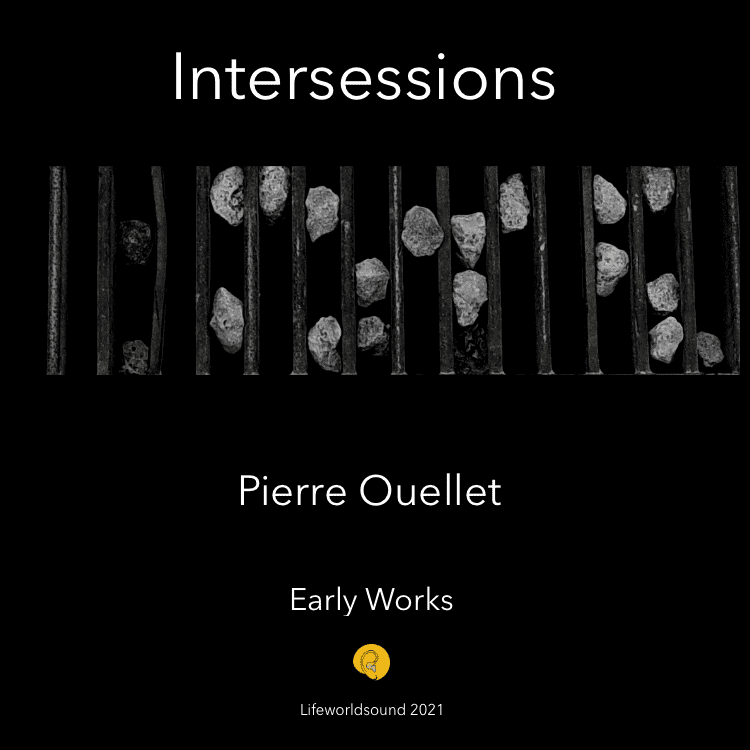
Piece for 4 Solo Clarinets and Synthesizer
The score for this piece (since lost) consisted of visual symbols, arranged in score form, to be interpreted by both performers – clarinet and synthesizer – as they played each section of the piece. The reading of the score was originally linear in approach but eventually, after many performances of the piece, came to also be understood as open to interpretation itself, according to the constructs of serial music and total serialism. In one version of the piece V.I, each section is played in sequence constituting the entire composition. In another version V.II, the four sections, once each played, are superimposed against each other and replayed, in a performance space, from individual speakers. In a further variation on this version V.II b or c, the performers perform live against pre-recorded tracks of the other parts, either once of twice through the parts themselves.
Metalways
Sometime in 1978 I came to have access to a large sheet of metal and became very interested in its Sonic possibilities. I found different types of microphones that could both be applied to the surface of the sheet and or placed at various distances from it in a few different acoustic spaces. Using different setups, I began exploring the various sounds that I could produce by rubbing scraping dampening and hitting the metal surface again with different kinds of implements (mallets, brushes, drumsticks, and so forth). I spent a lot of time trying to coax different and unusual sounds from the surface at hand all the while recording a number of these efforts limited only by the lack of availability and the cost of audiotape itself. After all I was a student and did not have a lot of money in fact often I had none. The piece Metalways is the result of this exploration and it’s formalization into a concrete composition which was commissioned by the Judy Jarvis dance company in the summer of 1978. I had known Judy from a previous commission and when I played her some of the ideas that were coming from my explorations with this metal sheet, she asked me to put together a piece that she could use during a series of concerts which she had planned for that summer. As part of the deal, I was also to be the sound man every night which allowed me to hang around with dancers all summer as well as develop a better understanding of how such performances came together both technically and creatively.
Bird Waves
I studied electronic music at York University in the mid 1970s as part of my interest in experimental sound and avant-garde music. It is at York that I was exposed to the ideas and works of New York composer Richard Teitelbaum. Richard was a friend of Bob Moog, and together they created electronic circuitry that could be used, in conjunction with a brainwave monitor, to trigger sounds in a purposeful and intentional manner by entering into an alpha brainwave producing state. To say the least, the idea of making music directly from one’s brainwaves was immensely attractive to me as a young composer. So I found a brainwave monitor at a scientific supply store (Edmund Scientific), played around with achieving the various brainwave patterns, hooked it up to a pitch to voltage converter and used the CV to trigger my Synthi A synthesizer. Bird Waves is the result of this “musical” experience. At the same time, in our pursuit of a quiet mental space from which to do our improvised performances, the Interspecies Music experimented with biofeedback at a Toronto lab. While some members of the group were more successful than others at achieving alpha waves, all took away something positive from the sessions.
Interspecies Music Performance – At the Music Gallery – Toronto – 1977. See website for performers and additional information.
Although I initiated, organized and played in all these pieces, credit is, in fact, due to the talented and creative performers who truly made these works possible. From an intuition, to a plan, to a performance, this music evolved and came to be, primarily, through the goodwill and inspired efforts of all who took place in it. I thank them all from the bottom of my heart and hope that this recording will continue to remind us of a time where we believed in ourselves and each other and thought, from deep in our spirit, that anything was possible.
Credits
Piece for 4 Solo Clarinets and Synthesizer (recorded at Eastern Sound, Toronto, ON – engineer Michael Jackson – produced by Pierre Ouellet – Clarinets Robert Stevenson – Synthesizer Pierre Ouellet (1978)
In Transit (recorded at OCA sound studio – performed, engineered and produced by Pierre Ouellet (1978)
Bird Waves – performed by Pierre Ouellet – Toronto – ON – 1977
Interspecies Music Performance – At the Music Gallery – Toronto – 1977. See this website for performers and additional information.
The Wasteland – Recorded at MARS & CO Studio and Venture Studios – Toronto – ON – performers – Kelita Haverland and Pierre Ouellet – 1978 and 2020.
All publishing, where applicable, by Venture Publishing – 2021.
A lifeworldsound project – all rights reserved 2021.